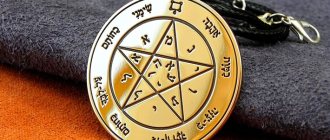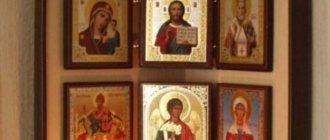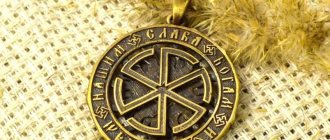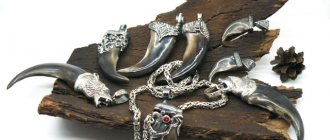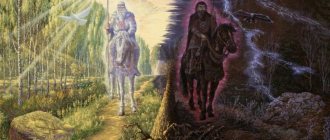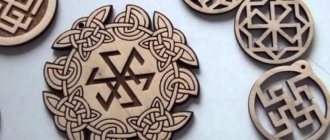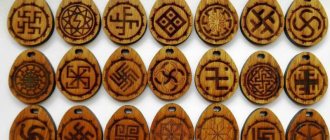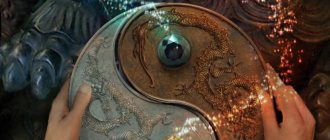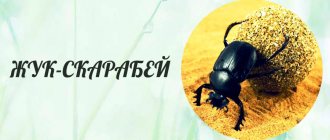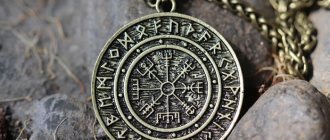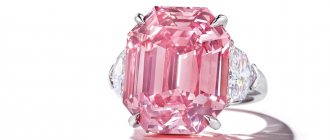The ancient Slavs revered many pagan gods, and Perun occupied one of the important places among them. He personified justice and thunder. The ancient Slavs believed that Perun was able to endow them with courage and courage and protect the lands from attacks by other tribes. They applied images of this deity to many objects and symbols. Moreover, lightning was his companion everywhere.
The sign of Perun has powerful energy.
About the Slavic god Perun
Perun is one of the most revered gods in the Slavic pagan pantheon. The son of the fertility goddess Lada and the blacksmith god Svarog was born on a stormy day. His birth was marked by a strong storm, hurricane winds and peals of thunder.
When Perun grew up, he subjugated the power of lightning and storms. But its power was not destructive. God caused rains, thanks to which people received a generous harvest, and also saturated the earth with the power of Fire. Perun showed interest in his father's craft and spent a lot of time in the forge.
According to legends, he created weapons and armor that he used himself. Shaking his sparkling armor and clutching his trusty ax in his hands, Perun descended onto the battlefields and protected the warriors who worshiped him. God patronizes everyone who stands for a just cause, and mercilessly punishes liars and hypocrites.
To receive Perun's protection, you must carry one of his symbols with you. At the same time, talismans and amulets cannot be used to harm anyone. Perun patronizes only those whose hearts and thoughts are free from evil.
Story
Before the adoption of Christianity in Rus' on the Byzantine model in 988, most Slavic peoples adhered to a pagan religion. Among the deities revered by the Slavs, the god of thunder and lightning, Perun, stood out. According to legend, his father was the powerful Svarog, the creator of the earth’s firmament, and his mother was the goddess Lada, the patroness of female beauty and hearth.
Having matured, Perun learned to control the natural elements that ancient people were so afraid of. The Slavs believed that peals of thunder were generated by the wrath of a formidable god, rushing across the sky on a fiery chariot with a heavy club in his hands. He was depicted as a powerful man of mature age with a golden beard, dressed in heavy armor and a robe fluttering in the wind. The god's head was crowned with a winged helmet, symbolizing the rapid speed of his movement.
To receive mercy from Perun, the Slavs, starting from ancient times, made amulets to wear. The Thunderer was considered the patron saint of warriors due to his ability to inspire them to feats, so the Slavic princes wore his symbols even after converting to the Orthodox faith.
The meaning of the Ax of Perun amulet
Perun's ax is the main weapon of the Thunderer, with which he is most often depicted. According to Slavic beliefs, in ancient times a huge serpent swallowed the Sun and plunged the world into darkness. Perun went to battle against the monster and won with the help of a poleaxe (axe), and then returned the luminary to the sky.
Since then, the Ax of Perun has become a symbol of military valor, strength and courage. For many centuries, people have worn amulets in the shape of the Thunderer's ax in order to receive his protection. The meaning of the Ax of Perun amulet for men is:
- physical strength and endurance;
- self-confidence and determination;
- calmness and perseverance.
In addition, the amulet brings the owner good luck in any endeavor and helps to forget about fears and doubts. This amulet contains a huge supply of male energy, so it is not at all suitable for women. Children are also not recommended to wear an amulet, regardless of gender.
Silver pendant-amulet “Perun’s Axe”
Making a talisman in the form of Perun and its activation
You can make a talisman with a symbol yourself. Metal amulets are made by professional craftsmen. If you want to make a talisman with your own hands, you can use wood.
First you need to put a sketch on paper. Then you should prepare a piece of wood, a knife, sandpaper and chisels. With the help of a tool, the talisman itself is easily made from the blank.
Before use, the amulet must be cleaned and charged.
To do this, at nightfall you should light a candle and hold the talisman over its flame. At this time, you should tell the sign all the most secret things.
After completing communication, the item should be placed under a stream of moonlight. Just one night is enough to charge the amulet with cosmic energy. You can already use it in the morning.
Amulet of Peruns Color
The color of Perun is one of the oldest Slavic symbols. According to legend, the god of the Summer Sun, Kupala, gave the lord of lightning a fern flower. Immediately after this, the Thunderer fell in love with the beautiful goddess Diva-Dodola.
Since then, it is believed that this amulet opens and softens a man’s heart, making him more caring and gentle. For representatives of the fair sex who possess these qualities from birth, the Perunov Tsvet amulet can do practically nothing to help. For women, the Odolen-grass amulet, which refers to Kupala’s wife, the goddess Kostroma, is more suitable.
The meaning of Perun's amulet Color is not limited to amorous affairs. The amulet protects the owner from the evil eye, damage and other negative influences. Helps to gain self-confidence, unwavering decisions and iron will.
Most often, the Color of Perun is worn as a pendant around the neck under clothing. You can also hide the amulet in a bag or wallet, which the owner carries with him.
How to choose the symbol of Perun for a tattoo
Perun's sign, applied to the skin as a tattoo, will become an excellent protector for a person who honors his family and preserves the heritage of his ancestors. A tattoo with one of the symbols of the Thunder God will help you gain his strength, courage and wisdom, and become more just and strong in spirit.
The choice of signs of the patron saint of warriors should be approached carefully, because, despite the general warlike magical energy, each of them has a certain “shade”. It also has its own important features.
When choosing a symbol, you should also take into account the incompatibility of the signs of Perun and Veles, the opposition of which is legendary.
Let us note once again that women are allowed to wear the symbols of the Thunderer only as a temporary amulet or amulet - and even then not all of his signs. The Rune is also undesirable as a tattoo. If the runic symbol turns over during movement, its meaning will become reversed. This can have serious negative consequences.
Amulet Shield of Perun
This talisman was no less popular among the Slavs than the legendary weapon of the Thunderer. The drop-shaped Shield of Perun is considered a symbol of protection from the forces of evil.
According to legend, the lord of lightning himself forged the shield in the forge of his father Svarog. After defeating the huge serpent, Perun presented the shield to the inhabitants of Midgard (in Scandinavian-Slavic mythology this was the name for the world of people). The artifact protected all people from Chernobog and his servants.
Perun's shield was often depicted on the weapons and armor of warriors. The sign helped the warriors in battle, protected them from wounds and gave them strength. Often the symbol was drawn on the walls of residential buildings to protect the family from evil forces. The meaning of the Perun Shield amulet lies in bravery and courage, so women should not wear it.
The meaning of the sign for the Slavs
In fact, the sign of Perun has many interpretations. Each of them has its own unique features. Gromovnik is considered the most important talisman of Perun. It is also called the Wheel of Perun. In appearance, it is a six-pointed cross, which is enclosed in a circle.
This symbolism of Perun was most often used by warriors. It was believed that she would help protect her family. Gromovnik was recommended to be worn by young men and mature men. The sign was contraindicated for children, since it was believed that it could make the character too cruel.
The main task of the sign of the god Perun was to cultivate fortitude.
Using the symbol you can achieve the following results:
- become more courageous;
- protect yourself from injury in battle;
- develop self-confidence;
- receive protection from the evil eye and damage;
- become more resilient.
Gromovik also has additional properties. He protects a person and his home from evil people.
The main sign is considered to be the Thunderer.
Other effective symbols include:
- Ax of Perun. According to legend, God defeated the Serpent with this weapon. With the help of this amulet one can gain strength and develop masculine traits.
- Perunov Shield. It is presented in the form of a drop of water, turned upside down. With the help of the Slavic amulet Shield of Perun, you can protect yourself from physical attacks and protect your family from harm.
- Flower of Perun. According to the description, this symbol allows you to reveal the spiritual side of life and find your own purpose in it.
- Perunov's helmet. According to the interpretation of this sign, it imparts determination, fortitude, and courage.
- Rune. This talisman has different meanings - it all depends on the side. One gives a person powerful energy, the second allows one to cope with chaos in life.
- Star of Perun. This amulet is perfect for executives and doctors. It helps you make difficult decisions and find the truth.
- Sword. This symbol helps its owner to organize his life. With the help of Perun's sword, it is possible to replenish energy reserves and protect against black magic. He helps achieve justice. Perun's sword symbolizes the triumph of justice and helps everyone who needs it.
- Seal. This sign is best received as a gift from the mother. In this case, with the help of Perun's seal it is possible to protect against guile.
- Star of Perun. Since ancient times, it has been used by military commanders, rulers and guards. The meaning of the star of Perun is that it helps to find the truth, makes thoughts clearer and fulfills your plans. The sign helps you make the right decisions.
The Star of Perun is considered a powerful symbol.
Another popular symbol is the cross. It is a star with 4 rays. With the help of the cross of Perun it is possible to achieve success in military affairs. It can be worn by people who decide to devote themselves to protecting other people. With the help of the Perunov cross, it is possible to improve a person’s physical condition and strengthen his spirit.
Among the other symbols, Perunitsa stands out strongly. This amulet is presented in the form of lightning, which is enclosed in a star. It is used to attract good luck and help in difficult life situations. This sign is considered feminine. However, his patroness is characterized by certain differences.
In essence, Perunitsa is a warrior maiden. Some believe that she was the wife of the lightning lord, others are sure that she is his daughter.
In any case, the amulet helped to cope with the dark periods of life and brought good luck.
Perunitsa is a warrior maiden
Perunov Sword
The god of lightning and thunder personifies not only the unbridled power of the elements, but also justice and reason. Perun gives everyone what they deserve, so he always sees human lies and deceit. Using a talisman for evil purposes is not only useless, but also dangerous.
The Sword of Perun amulet is an artifact that primarily protects the owner from injustice and meanness. In addition, the amulet protects against:
- negative energy influences of any kind;
- the envy of ill-wishers;
- life's misfortunes;
- family troubles.
The talisman fills the owner with vitality to overcome any difficulties. A person who regularly carries the Sword of Perun with him gains the ability to stand to the end even in the most hopeless situations.
Who needs to wear a talisman
The amulet is suitable:
- Leaders or heads of families . Perun supports people whose authority should not be challenged. God helps to be fair and lenient towards subordinates. He does not deny gaining authority not only to men, but also to women.
- Representatives of hazardous professions . The amulets of the Slavic deity are used to protect police officers, firefighters, military personnel, etc.
- Indecisive and weak-willed people . The symbols of Perun will help a person discover courage and fearlessness in himself. At the same time, the owner of the talisman must himself strive to get rid of his shortcomings. Esotericists recommend mentally turning to the deity with a request to get rid of negative qualities.
Thunder stake of Perun
This symbol is also called the Thunderbolt or Thunderwheel. According to legend, Perun forged this artifact and with its help subjugated the power of lightning and storms. Using the wheel, God caused bad weather or, conversely, blessed the land and harvest.
Ancient Slavic warriors revered Gromovik along with the ax and helmet of the Thunderer. Women embroidered the symbol on the clothes of their lovers before a battle or military campaign. Warriors made wooden pendants in the shape of Perun's wheel themselves and wore them around their necks. After the baptism of Rus', this symbol was often combined with the Orthodox cross.
Gromovik looks like a Kolovrat with six rays. It is believed that it helps young men acquire the qualities of an adult man. In addition, the amulet:
- protects against wounds and diseases;
- helps to concentrate in difficult situations;
- strengthens the will of the owner.
It is noteworthy that the image of Perunov’s wheel was used as protection against thieves, so it was painted on the walls of houses.
How to make amulets with your own hands?
If you want to make an amulet yourself, it is worth considering that you should use only natural materials for this. The following are suitable:
- silver alloy;
- copper;
- gold;
- wood (oak or ash);
- goat or cow leather;
- stainless steel.
The talisman can be embroidered on the collar of a shirt or on the inside of the garment. It is embroidered with red wool or cotton. The color of the symbol should be bright. If you are making an amulet from metal, keep in mind that it should shine, and the more, the better.
We recommend: Ancient Slavic amulet Belobog: meaning of the symbol, cleansing and activation. How to do it yourself?
Star of Perun
And this amulet is suitable for both men and women. It will be an ideal assistant for people whose activities involve making difficult decisions. The Star of Perun is a landmark that will help the owner find himself in life, choose a profession, a life path.
In ancient times, the Star of Perun was depicted on the armor and symbols of power of rulers and leaders. It is believed that the talisman helps to collect thoughts, concentrate on one specific task, and weigh the pros and cons. The talisman is also suitable for people who go on long trips.
The Star of Perun is also considered a symbol of justice. The amulet can be worn in the form of a wooden or metal pendant. It is allowed to inlay it with minerals of light shades.
Who is the sign of Perun suitable for?
Battle signs, which include the Cross, Shield and Axe, can be used by boys over 16 years of age and adult men. They are not allowed to be worn by children due to the risk of cruelty.
It is not advisable for women to use such signs. They block feminine character traits and make their owner too masculine.
Girls can wear Rune, Perunitsa, Star. Fern Flower is also suitable for them.
Perunov Color is distinguished by its versatility in application. It can be worn by people of any gender and age. This option is especially relevant for those involved in science and military affairs. The amulet can also be worn by travelers. It helps to find happiness and brings peace to the soul.
The amulet should not be worn by people with evil thoughts who want to harm others. The talisman is not suitable for black magicians. Perun is considered a cruel but fair god. Therefore, he will not punish anyone in vain. The symbol is not suitable for people who think only about material well-being.
An amulet with the Perunov sign is suitable for adult men and young men.
Amulet Perunov Arrow
This artifact is best suited for the military. It is shaped like an arrowhead. Traditionally it is made of metal. Since the arrow is related to Perun, the fighter against evil, silver is often used to make a talisman. This metal is endowed with light energy and represents purity in many religions and cultures.
The amulet can be worn around the neck as a pendant, or attached to a bag or clothing. Despite the fact that the talisman has the shape of a weapon, its functions are purely protective. Therefore, it is better to wear it openly so that the amulet is the first to take on the negativity.
There are no strict restrictions on wearing the artifact. It is suitable for both men and women. As for children, it is still better to choose another option for them.
Interesting video on the topic
The story of Perun’s birth and growing up, his role in the Slavic pantheon of gods, depiction options, a story about attributes and divine commandments:
The attributes of the thunder god are very diverse, both in form and in essence. Among the signs there are amulets suitable for both women and men. They can be used for personal protection or to protect home and family. The most important thing when wearing the symbols of the Slavic god Perun is to comply with the established divine rules, use power for good, and bring justice and goodness to the world.
Helmet of Perun
This is another protective amulet related to the military equipment of the Thunderer. Unlike other talismans, the Helmet was used not as protection in battle, but as a talisman against love spells and other influences on a person’s consciousness.
In addition, the artifact helps to become more diligent and concentrated. The amulet's energy is more suitable for men and young men, but women can also sometimes use it.
It is important to remember that the Slavs believed in the destiny of men and women, therefore each gender has its own amulets. Do not abuse “foreign” energy.
Seal of Perun
This is another amulet with masculine energy that was traditionally made by women. Very often, the bride handed the Seal of Perun to the groom, recognizing his rights and responsibilities as the head of the family. The amulet helps a man protect his home and family, raise worthy offspring and earn good money.
The Seal of Perun also grants the owner:
- courage and composure even in the most dangerous situations;
- endurance and prudence to solve problems;
- perseverance and willingness to put in effort to achieve results.
You may also be interested in:
Ax of Perun Amulet
Chain of Perun (gold)- Bracelet Perun. Silver
- Perun bracelet
- Shield of Perun
- Bracelet Perun
Bird of Perun
The god of lightning and thunder was often depicted with a falcon or eagle. Traditionally, the bird had an open beak from which flames burst out. An amulet with this image is given to men by their mother or wife. Also, the symbol of the Bird of Perun was embroidered on clothes.
The artifact provided warriors with protection from enemy weapons in battle and gave them courage. In peacetime, it was used to achieve well-being.
Now it is believed that the Bird of Perun amulet helps the owner:
- become more confident and decisive;
- acquire material goods;
- resist negative energy influences;
- think and make decisions independently;
- strengthen willpower and spirit.
The talisman is not always carried with you. Sometimes it is placed under the marital bed; it is believed that the artifact will help conceive a son.
Perun's opposition to the forces of chaos and darkness
It’s in vain that we forget the valor of times past and keep our way to God knows where. Looking back, we say that we are ashamed to know Nav, Reality and Rule and to know and comprehend both sides of our existence
Veles' book." Part III. "Busovo broadcasting"
According to the mythological legends described in the “Songs of the Bird Gamayun”, Perun was born in bright Iria by the goddess Lada Mother. Tempered by the fire that burned in the Svarog Forge, he received from his father Svarog a thunder club and a fire-maned horse, an assistant in military exploits. The personification of the dark forces of Navi and the creation of evil in those days was the Skipper-beast, he had a lion's head, copper wool, horns, damask hooves, and on his tail there was a poisonous scorpion sting. He dragged the Perunov sisters: Lelya, Zhiva and Morena into the kingdom of darkness, depriving the open world of summer, spring and winter. Yes, for three hundred years and three years the god Perun was hidden from the world of light. Chaos reigned on earth, and people asked the omnipotent gods to deliver them from the Skipper and restore order in the manifest world. After this time, Mother Sva, Mother Lada, shone in the bright sky and called on the almighty Svarog, so that the gods would find Perun and return him to the open world, for only Perun’s light power could defeat the Skipper-beast generated by darkness. The Irian gods began to look for Perun, but the god Perun was hidden underground, however, following the signs indicated by Perunov’s horse, his devoted assistant on earth, and the heavenly eagle - Perun’s faithful companion in heaven, the gods found the cave in which the ruler was hidden of darkness Skipper god Perun.
The gods awakened Perun from sleep with life-giving water, and the sacred surya, the bird Gamayun brought from the Riphean mountains, gave Perun a drink, and she filled him with great power. Then, flashing with bright lightning and breaking apart the menacing clouds with a thunderclap, Perun rushed off on his faithful horse to look for Skipper, the ruler of the dark kingdom. Perun rode on a mighty horse along the roads between the worlds, and the heavenly law affirmed along the way. Arriving in the kingdom of darkness, where Skipper ruled, he freed his sisters Perun from the spell of the fierce beast. The dark beast could not seduce the spirit of the pure god, the bright and righteous Perun, he promised mountains of gold, all his power, so that the formidable Perun could rule the whole of heaven with its help, but Perun rejected all his treacherous gifts, for that gold, washed with human blood, was wrong, and the power of Skipper, generated by Krivda, was not needed by the fair god Perun. Perun defeated the Skipper-beast in battle, freed the open world from his dark dominion, and re-established order on earth and heaven.
When the time came for the terrible and fair god to marry, he chose the goddess Diva-Dodola as his military companion, the inspiration for feats of arms. But the king of the sea, the Black Sea serpent, the three-headed creature of darkness, living in the underwater white-stone kingdom, wanted to take away his beloved Perunova, the beautiful-faced one. Driving his golden chariot harnessed by eight mighty horses, he advanced in darkness onto the Irian garden and demanded that Svarog give him Diva-Dodola as his wife. Turning into a gray eagle, Perun flew in, and all the power of heaven gathered to help - Veles, Stribog, Semargl, Khors - in order to drive the snake out of the monastery of the most pure Svarga, then he fled to the bottom of the sea, and plunged into darkness and darkness forever and ever. Thus, the gods of the bright Iriy, led by the brave Perun, defeated the offspring of the dark kingdom of the sea - the fierce serpent.
Perun god of the Slavs in ancient chronicles
In addition to the chanting of the valiant deeds of the god Perun in the sacred ancient legend “Songs of the Bird Gamayun”, the oldest primary source of knowledge about the past and the sacred scripture of our ancestors “The Book of Veles” also has its own tale about him. Here he appears as the patron god of warriors and farmers, he is glorified as a god who disperses darkness and illuminates the eyes with divine light, shining with his sword, striking down the enemy with it. It is said that they turned to Perun for support in times of cruelty, when foreigners attempted to seize our lands, for he is a god, calling with ardent heavenly thunder to a righteous battle against the invaders. He is also glorified as a god whose power encourages the earth to bear fruit, shedding rains that are sent to the earth by the will of Perunova. He is called the giver of blessings, comforter and protector, Father and Leader.
The Tale of Bygone Years, dating back to the beginning of the 12th century, tells the story of how the idols of six gods were installed by Prince Vladimir, among whom Perun was the main one. The Slavic god Perun was considered the supreme deity of Kievan and Novgorod Rus'; he headed the pantheon of gods of ancient Rus', among which Khors, Dazhbog, Stribog, Semargl and Makosh are also mentioned in the Tale of Bygone Years. The chronicle also tells of the conclusion in 6415 (907 AD) of a peace treaty with the Greeks, sealed by Prince Oleg and his squad with an oath of arms and the name of the gods Perun and Veles.
Mentions of the god Perun are also found in Christian chronicles, such as the “Novgorod First Chronicle of the Younger Edition,” dating from the end of the 11th century, which states that in 6488 (980 AD) with the beginning of the reign of Vladimir in Kyiv , a wooden idol of Perun with a silver head was installed on the top of the hill. It also talks about the time when Vladimir began to eradicate the original faith of the ancestors in Rus' in 6496 (988 AD): the idols of the gods were thrown into rivers, they were chopped up or set on fire. Unprecedented cruelty was shown to the idol of Perun: he was tied to the tail of a horse and dragged from the mountain to the river, while they beat him with rods, after which they dragged him along the river to the Dnieper. All this action was carried out for show in front of the people, who were saddened by the bitterness of watching what was happening.
Therefore, Prince Vladimir could not destroy the people’s faith in the gods - back in the 14th century, the clergy of the Christian church complained that in the outskirts they still continued to worship the god Perun. Back in the 18th century, during a drought, the Bulgarians held rituals with young people going home, singing and glorifying Perun, and people called on him to wash the parched land with blessed rain. Researcher of Russian and Slavic folklore A. S. Famintsyn in his book “The Deities of the Ancient Slavs” cites the memories of the German traveler Johann Wunderer about visiting Courland in 1613, where he discovered not a Christian church, but a sacred tree - a majestic oak, which was the center of worship for Latvians and was called by them as “Perkunov Oak”.
Analogies in other beliefs
Over the millennia that have passed since the exodus from the northern ancestral home, also as peoples and ethnic groups settled, there was an inevitable transformation of the original unified faith and endowing it with special characteristics and unique features characteristic of each people, caused by both the new habitat and new living conditions. However, in the mythological tales of different peoples today, one can find obvious similarities in plots telling about the confrontation between darkness and light, the personification of chaos and cosmic world order. The identity of the general Indo-European mythological plot about the struggle of the thunderer, who is the force that orders space, is traced, with a snake or a creature of the serpentine breed - the personification of chaos, destroying order and harmony in the universe. Thus, the thunder god acts as an antagonistic force to chaos, darkness, inertia and passivity.
However, even in the names of some gods, not only etymological similarity can be traced, but also the identity of the basis - the root. Thus, the name of the thunder god Perun is consonant with one of the epithets of the god of gods of the Vedic pantheon, the thunder god and leader of the army of Indra - “Parjanya”, under this name Indra appears in the Vedas in one of his aspects - as the god of thunderstorms and rain. Parjanya (Sanskrit: पर्जन्य) means 'rain' or 'rain cloud' in Sanskrit. Some hymns appeal to him for protection, and he is described as roaring like a bull and racing through the heavens on a chariot filled with rainwater, the bearer of great weapons, striking thunder and lightning at rakshasas and demons, or as the earth-giving Spirit. He is the god who strikes with thunder all those who violate divine laws and rules over the entire living world. It is also compared to the buffalo - as a productive force. Sometimes he appears accompanied by the Marut wind deities. The weapon of the god Indra is the thunder arrow Vajra - a symbol of power over dark forces. Indra is opposed by the personification of chaos and darkness Vritra - similarly, Perun opposes the creature of darkness and chaos, the Skipper-beast. Perunov Storm-horse is essentially the same Uchchaikhshravas - the flying white horse of Indra.
The god of thunder and lightning, storms and fertility, the protector of gods and people in Scandinavian mythology is Thor. The valiant son of the supreme heavenly god Odin, who is also considered the patron of military valor. The Swedish pantheon of gods was originally headed by the god Thor, which is confirmed by numerous archaeological finds - amulets of Thor's hammer (Thor's hammer was called Mjollnir4). One way or another, the military function, later attributed to the god Odin, initially also applied to Thor; it was he who personified military strength and courage. In mythological Scandinavian legends, we can trace a similar storyline regarding the struggle of the thunder god with a certain monster - a creature of darkness and the underworld. Thus, Thor is opposed by the world serpent Jormungandr. Thor kills the serpent, frees the cattle and waters, and pours fruitful rain onto the earth, accompanied by thunder and lightning. Thor, according to archaeological information, just like Perun, was associated with the cult of the oak.
In ancient Greek mythology, Zeus corresponds to Perun. The god of heaven, thunder and lightning, Zeus was also revered as the main god of divine Olympus, the father of gods and people. His attributes are a shield and an axe. In divine deeds he was always accompanied by an eagle. Zeus defeated the hundred-headed monster-dragon Typhon, with hundreds of fiery lightning arrows he incinerated him and overthrew him into gloomy Tartarus.
In ancient Roman mythology, the god of thunderstorms, fertility, the supreme ruler of the heavens, the father of the gods appears under the name Jupiter. The god Jupiter, like Perun, was revered on high places. His heavenly abode was on high mountains, from where he watched everything that happened in the world. He expressed his will with thunderclaps and flashing lightning. Full moon days, the so-called Ides, are dedicated to him.
Among the Baltic peoples, the thunder god was revered as the main one in the pantheon of gods. Perkun, or Perkunas, among the Latvians was the highest ruler, the oldest father, sitting on the clouds and watching what was happening on earth. He was revered as the creator of lightning and thunderstorms (“thunder” - perkons, “lightning” - perkunija). In Latvian Courland the word perkuhns means 'thunder'. In folk songwriting we find numerous references to the thunder god, as someone rushing through the heavens in a chariot drawn by nine horses. He also has nine sons - three trinities: three strike, three more thunder, and the remaining three throw lightning. In conspiracies, people turned to the Thunder God for help to ward off illnesses and get rid of evil spirits and dark forces, in particular from envy and the evil eye. The Baltic Slavs, according to the testimony of the Danish chronicler Saxo Grammaticus, worshiped a five-headed idol of the thunder god: four of his faces were depicted on the shoulders and one on the chest.
In the traditions of the Lithuanian Zhmud tribe, the god of thunderstorms Perkun (Percunos) was the head of the pantheon of gods - a good god, a giver of benefits in the form of heavenly moisture, fertilizing the soil. His female hypostasis was also revered - Perkuna-tete - the mother of lightning and thunder. It was believed that she washed the divine face of the luminous Sun, after which she released it, renewed and purified, to again give light and warmth. And the spells of the Litvins also reflect the primary role of the god Perkun in their lives - he acted as a destroyer of dark forces and a deliverer from evil demons.
The Prussians revered the heavenly triad of gods: the god of heavenly light, thunder and lightning Perkunas, the god of waters and fertility Potrympos and the god of destruction and inferno Poklus. In one of the main sanctuaries in Romo (u)va in the province of Nadrovia6 there was once a main sanctuary and an altar under a sacred oak with images of this triad of gods, and this oak was considered the abode of the triune god. In honor of Perkūnas, the unquenchable fire “znich” always burned. The Prussians glorified Perkunas on the days of the spring equinox, the priests addressed him as the lord of thunderstorms and storms, as well as the giver of merciful rain, so that bread and grass could grow on the fertile soil. At the same time, they asked him to be taken away from Poklus, so that there would be no harm from the appearance of his all-destroying whirlwind. One of the days of honoring Perkunas is February 2 (on this day Perun is glorified - Gromnitsa, or winter Perunia). In folklore there are tales that Perkūnas pursued the god of the underworld Välnas.
We also see that in the veneration of the thunder god, not only essential, but also etymological similarities can be traced in the name with which different peoples subsequently designated him. So, in the sacred “Avesta” - in Iranian mythology, Tishtrya is the god of rain and the horseman of heaven, destroying the creatures of dark forces, leading the heavenly army, fighting the demon of drought Apaosha. Hurrian7 god of thunder and lightning Teshub. Among the Hutts8 it also corresponded to the thunder god Taru. The Hittites and related Luwians9 revered the thunder god Tarhunt. Pirva is the god of the Hittite pantheon of gods, patron of warriors. His sacred bird is also the eagle. In Akkadian mythology, this is the god of storms, winds, thunderstorms, lightning and rain, Adad, or Ishkur. Taranis was the god of thunder in Celtic mythology. Etruscan10 supreme god of thunder, just ruler of heaven and light, father of the gods, ruler of the entire world order - Tin(i). Urartian11 god of thunder and war Teisheba. Thunderer, god of thunderstorms and lightning, patron of livestock and crops Perkele (Ukko) among the Finns. The god of fertility and justice, Prove, was revered among the Slavs who lived in German Vagria.
Name of the god Perun
The word "Perun" in almost all Slavic dialects means 'thunder'. Lightning is also called "perun". In Polish the word piorun means 'lightning'. In Latvian, “thunder” is called pērkons. In Lithuanian, “thunder” is perkūnas, and “thunderstorm” is perkūnija. As mentioned earlier, the Sanskrit word parjanya is 'thundercloud, lightning'. At the same time, the word with the meaning 'mountain' is parvata, and we already know that the veneration of the god Perun took place on the hills. If we trace the obvious similarity of the names of the thunder god in many dialects of Indo-European languages, then we can confidently say that the name of the god Perun was preserved in its root basis among many peoples of Asia and Europe, and etymological similarities are also observed in the meanings of the name itself: thunder, lightning, rain clouds, mountain, hill, rock.
Image of the god Perun
In images of Perun we see a thunder club, ax or sword in his hands. His weapon is also a bow with gilded arrows, with which he fights against dark forces. Perun is usually depicted among flashing lightning in the skies. Accompanying Perun is a bull, possessed of uncontrollable and furious power, his storm horse is formidable with a gilded mane, adorned with pearls of heavenly beauty, and on the top of Perun's Oak, which is the sacred tree of the thunder god, sits the heavenly Eagle, a faithful assistant in his glorious deeds.
Perunitsa
This talisman is an exception to the rule, as it is intended for women. At different periods, the Slavs called Perunitsa either the daughter or the wife of God. Both in ancient times and in the modern world, women sometimes have to take on the responsibilities of a man.
Perunitsa helps girls become braver and stronger.
The amulet gives strength to protect your loved ones, perhaps even with a weapon in your hands. In addition, it is believed that the talisman helps the fair sex during childbirth.
